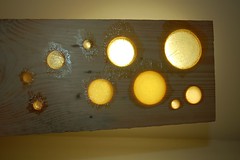I also played with the new 3watt power LEDs that I got from Rapid and I'm still not sure a) how hot I should let them run and b) whether it's safe to use them in a lamp. However, it's for a reading lamp, so it'll be me using it and I'll always be around when it's on. So I guess the thing now is, why don't I just make a lamp and see how it goes - yes, that's the way forward. Simple is best, so I'll try keeping the temperature of the LEDs down (which also means that the light will be comparatively dim) and mount them in a block of wood taken from a pallette - you know the cuboid blocks used to divide the upper and lower surfaces.
The thing that gets me about the LEDs is that you can run them very hot or not and if you want to have them at their highest intensity (i.e. the intensity at which they will still have a good long life), you have to take a leap of faith and just wire them up and hope they last. I think that way forward is to have more of them run dimmer for the moment. The other thing about them is that they are quite sensitive and while I'd like to just wire them up this article about building a specialised circuit to feed the power to the LEDs leads me to believe that they should be approached in a more delicate fashion and be linked to a sort of regulator circuit.




No comments:
Post a Comment